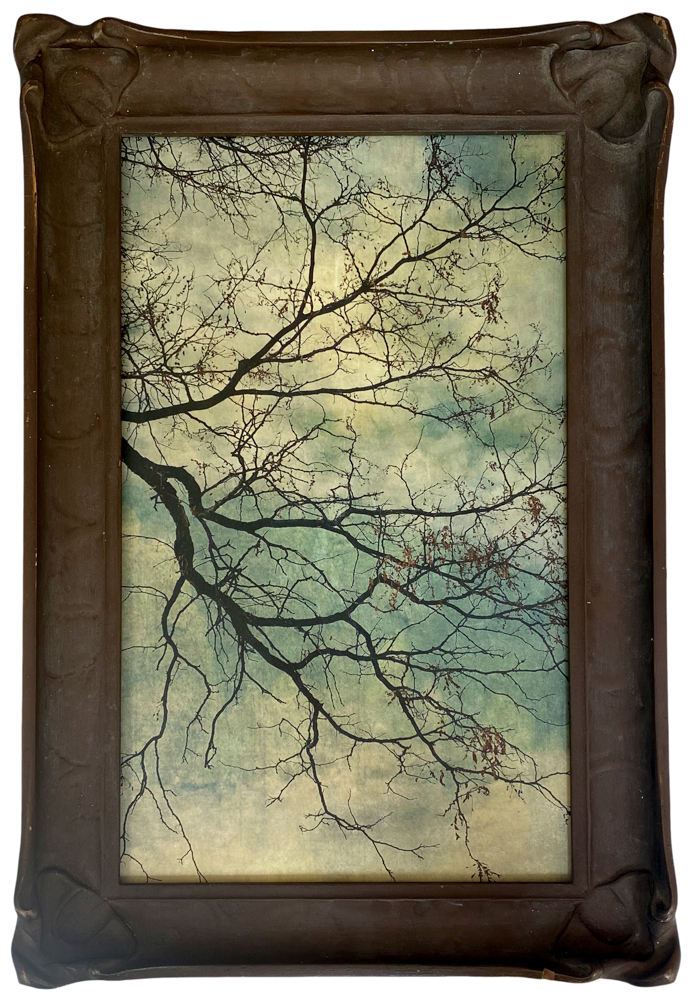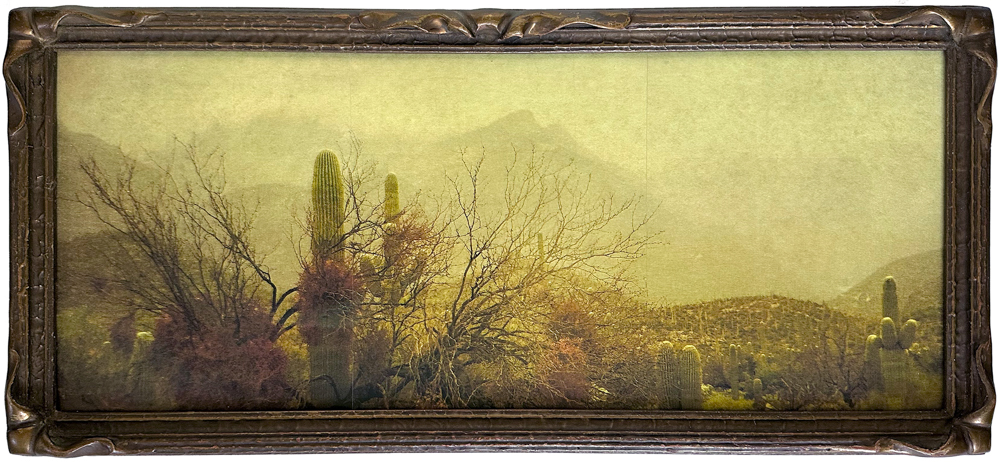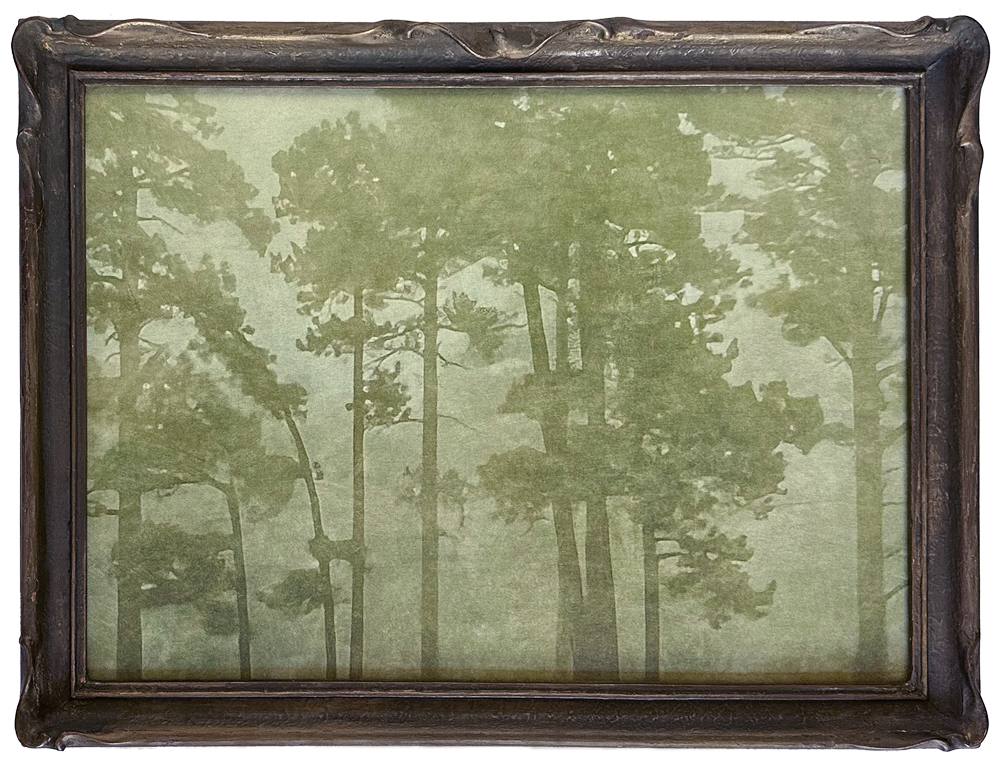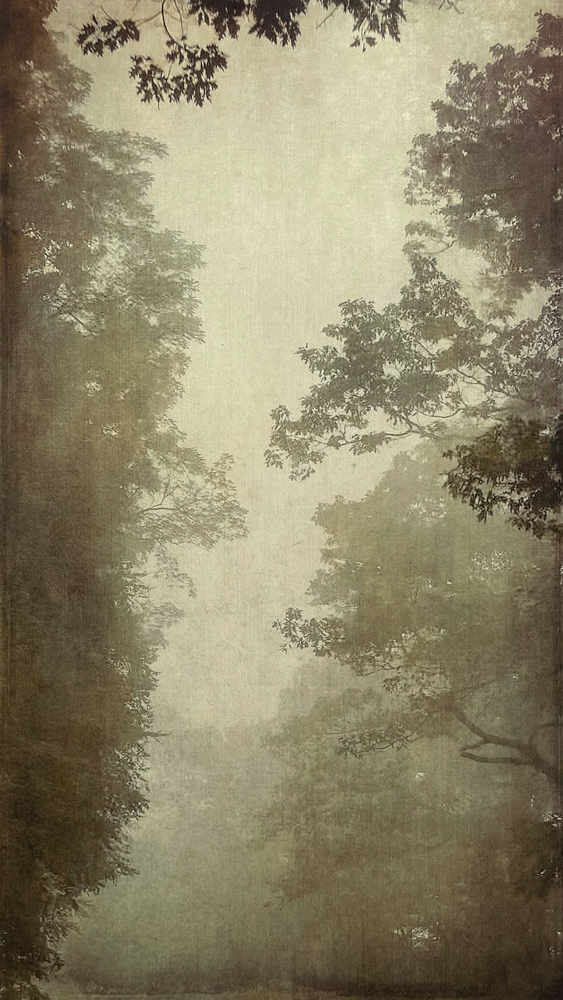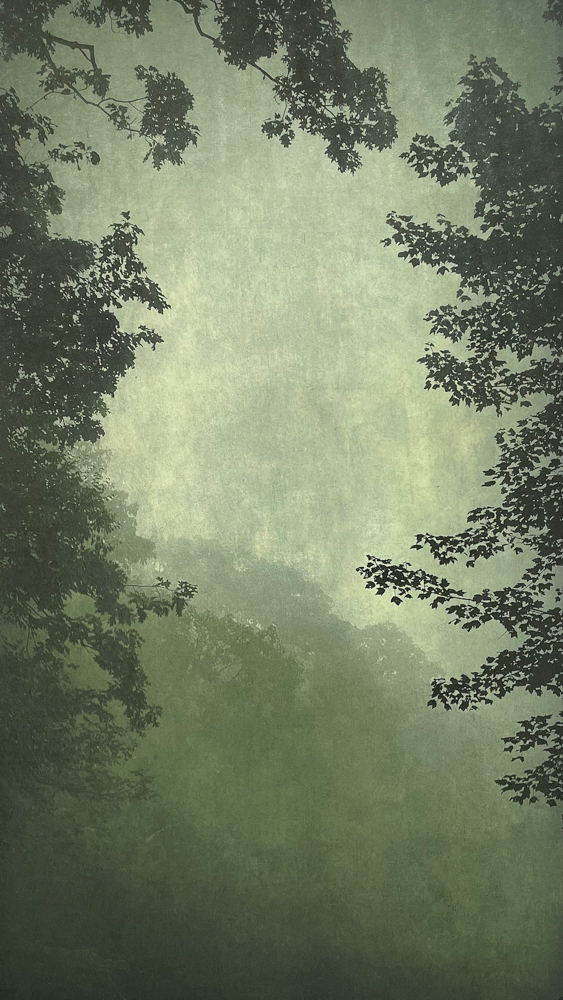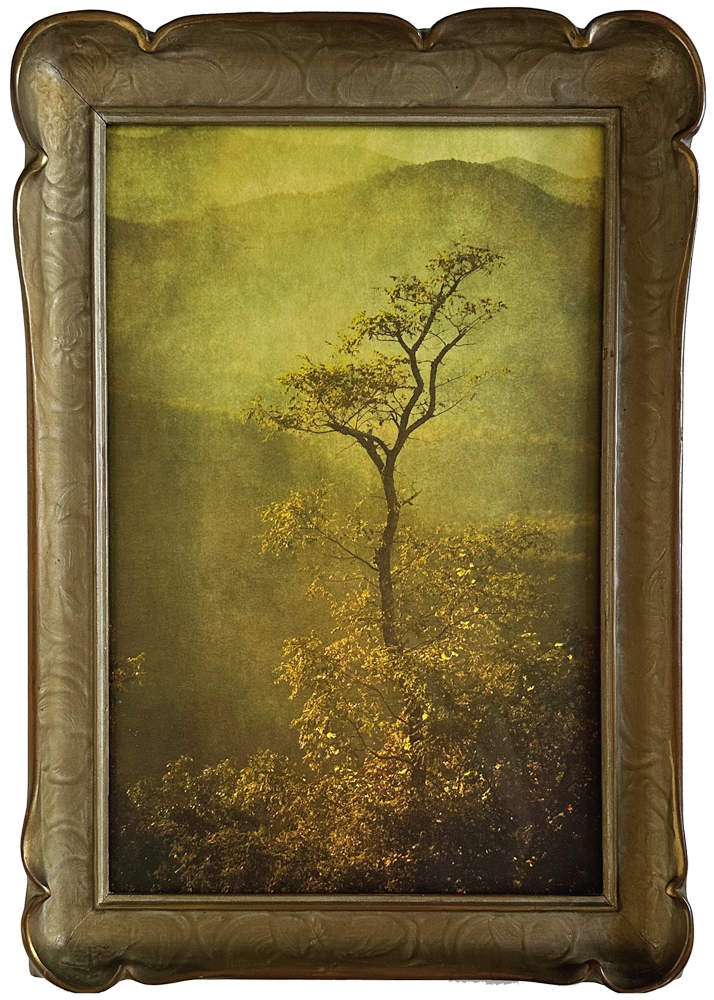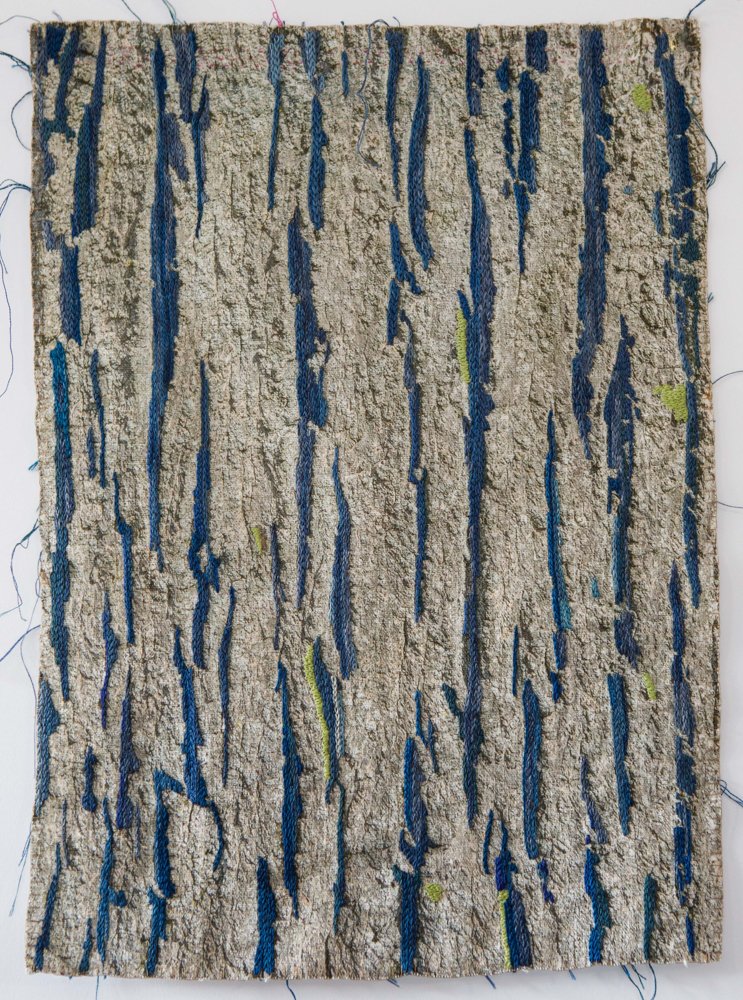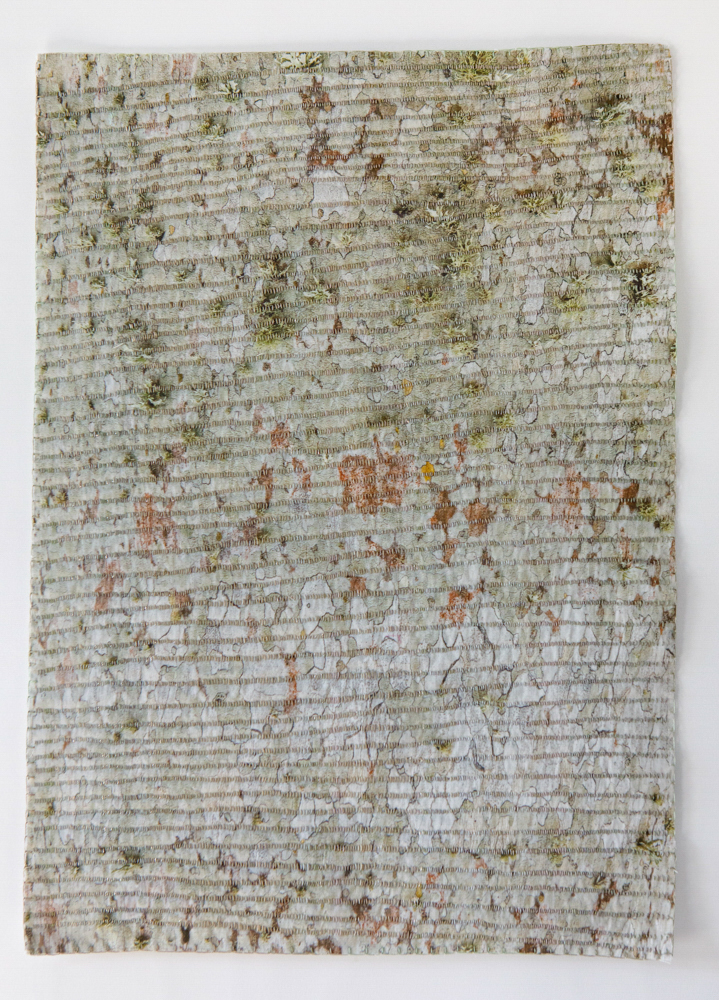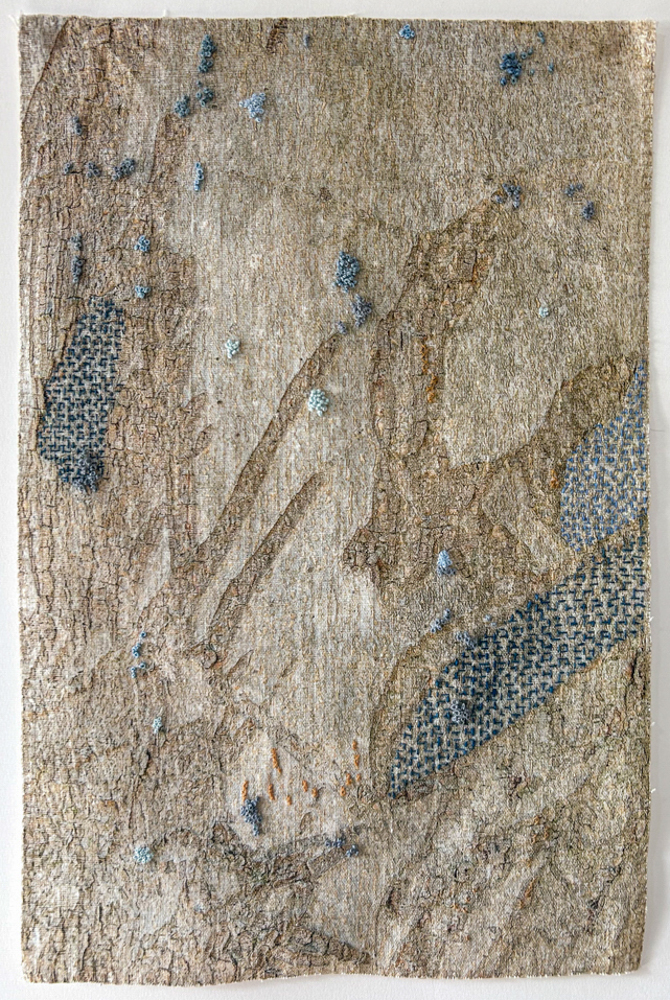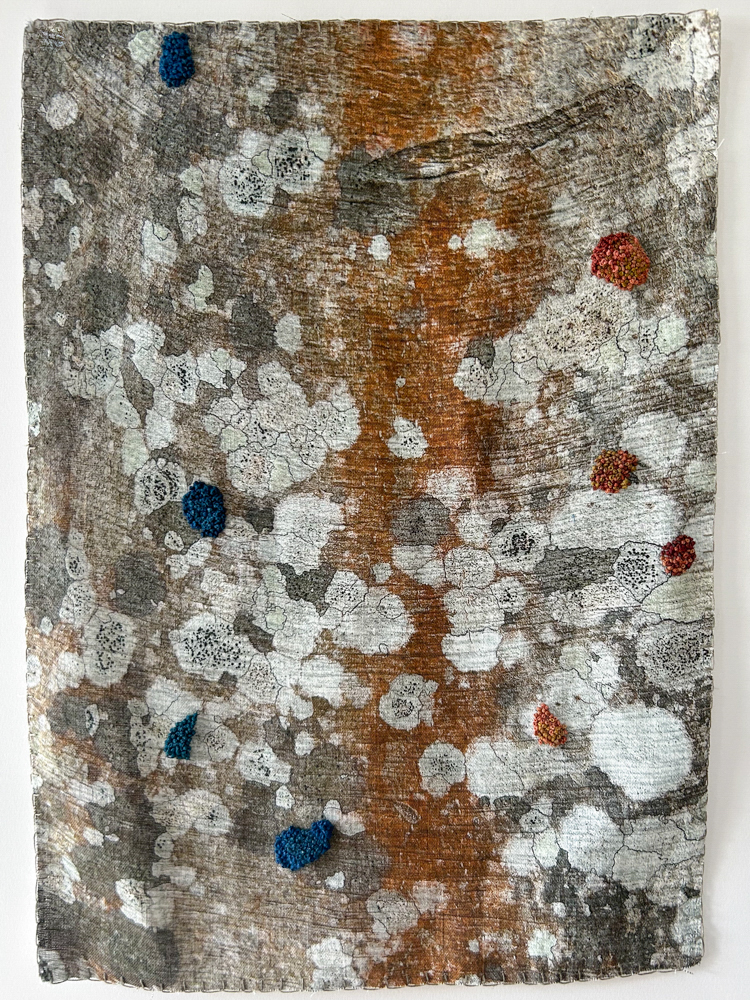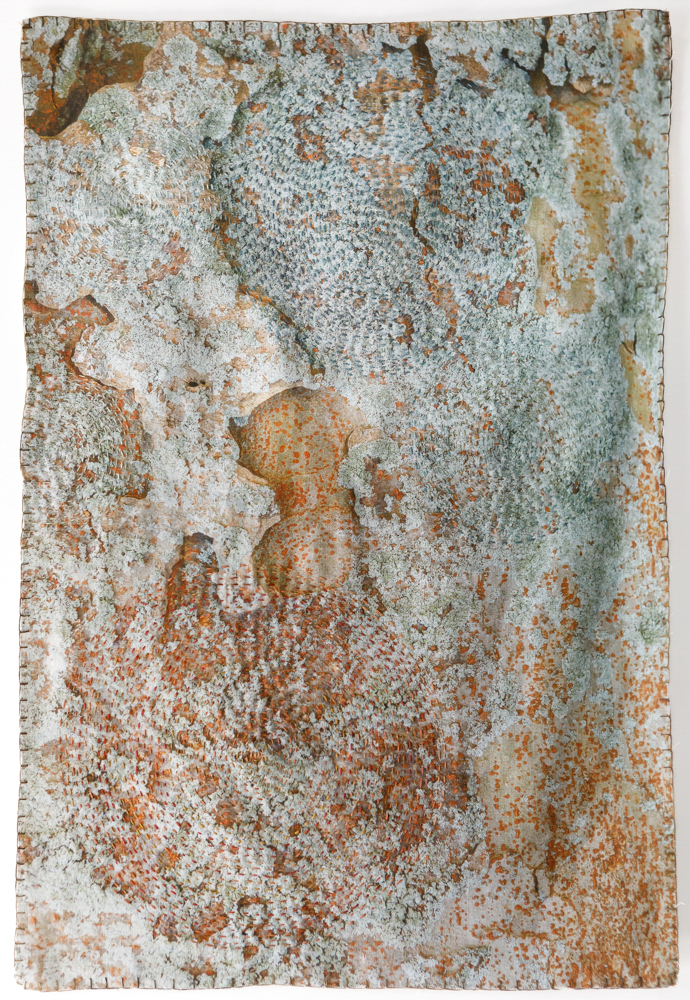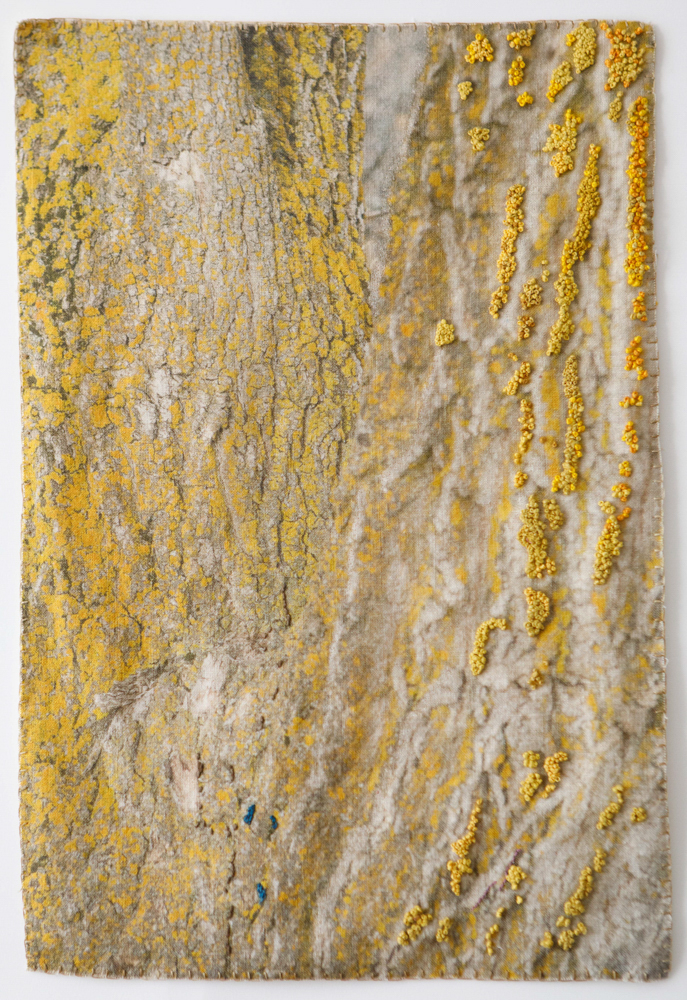Photographers in Conversation: Wendi Schneider and Laurie Lambrecht
“Those who contemplate the beauty of the earth find reserves of strength that will endure as long as life lasts. There is something infinitely healing in the repeated refrains of nature — the assurance that dawn comes after night, and spring after winter.”
–- Rachel Carson, The Silent Spring
The Etherton Gallery in Tucson, Arizona has just opened the exhibition, Reverence: Laurie Lambrecht and Wendi Schneider, that runs through June 10, 2023. Reverence pairs Laurie Lambrecht’s embroidered photographs on linen with Wendi Schneider’s gilded photographs on kozo paper, highlighting recent directions in object-based photography. Claire A. Warden’s photographs from the series 99 Moons will be on display “In the Cases.”
Sharing exhibition walls with another artist is always a great opportunity to connect more deeply with a photographer whose work is in conversation with your own. We continue the conversation off the wall and onto the page as Lambrecht and Schneider explore each other’s practices and influences. Their dialogue follows.
Laurie Lambrecht: When did photography become important to you?
Wendi Schneider: In 1981. I bought a Nikon to create references of models for my oil paintings. I was a designer/creative in Marketing at The Times Picayune in New Orleans and was fortunate to develop inspirational friendships with artists, photojournalists, and journalists. The marketing photographer, Colleen Soule Lastrapes, taught me the basics of printing. I fell in love with life through the lens and the alchemy of the emerging image in the darkroom.
While I felt I could express myself more eloquently with a photograph than a painting, I missed the sensuousness of oils, so began painting on my fiber prints. I tinted traditionally, then moved to layering with oils, as I had on my paintings. The photographic image always showed through, but the metaphorical lines were blurred. I felt I could offer a more personal interpretation if I transformed the prints and appreciated the uniqueness of an altered print. Ultimately, it was because I could find focus and surrender to the moment – art is my version of religion, where I find spiritual connection and find myself.
LL: Is your imagery often about trees or the landscape?
WS: Often in the last twelve years, but not always. When I worked in editorial and advertising, I was often a go-to photographer for still life, fashion, ribbons, flowers, sensuous figures – anything with curves that echoed the fluid lines of Art Nouveau and Arts & Crafts, which I first encountered as a child while watching the 1964 film My Fair Lady. But even before then, trees were an important part of my life. I spent hours in my youth beneath the undulating limbs of a weeping willow in the far corner of our yard. I reveled in the senses – the smell of the grass, the sound of the breeze in the leaves, the texture of the grass, and the view of the mesmerizing branches. There I found solitude and tried to figure out how I fit into the world. In elementary school, my favorite teacher, Mrs. Callahan, let me go outside to draw during art period. As a teen, I spent afternoons driving along bough-covered country roads.
Having lived in the lushness of Memphis, New Orleans, and New York, it was an adjustment to the senses moving to Denver in 1994, and usually by January, I was pining for green. I returned to long country drives around 2012 when photographing owls, other raptors and large birds. I gained an appreciation for the abstraction of bare branches, especially when I could see nesting raptors. I began photographing trees more frequently after making ‘Locust’ near Asheville in 2016, and many of my photographs over the years have been captured in our neighborhood while walking our dog Truffle, or her predecessor, Tallulah.
I visited my sister as the summer ended in 2020 for shinrin yoku, or forest bathing. The ‘Into the Mist’ collection was made on a short drive on the Blue Ridge Parkway. I felt comforted and outside of time as we drove along the winding road embraced in fog and arching branches. Whether photographing trees and landscapes, flowers, birds, or whatever I’m drawn to, my work is a celebration of all of the senses anchored in the visual.
LL: You mentioned the weeping willow of your childhood. Is there a tree now that you go to?
WS: Five years ago, we created our sanctuary in the backyard where I spend a lot of time. We’re surrounded by neighboring trees, including a venerable black locust. I added a Chokecherry and what was supposed to be a Weeping Birch but, alas, it only weeps when it snows!
But there are two Kentucky Coffee trees beyond my bedroom window in the neighbors’ yard – I photograph them first thing many mornings and often at dusk. They are my touchstone to begin the day with gratitude. Every moment’s light and mood is different. Even when I’m photographing the same square foot on walks, the view is constantly evolving. I sense time, change, memory, light and submerge in the organic nature of nature.
LL: One thing I’ve been wondering about from the bit that I saw of your work is your use of antique frames. I think that that’s really a wonderful extension. And you just mentioned the influence of Art Nouveau on your work and your sense of art history. Would you elaborate on that a bit? What comes first? Do you find great frames and then say, “oh, let me find an image that works here,” or vice versa?
WS: I call this body of work the ‘Patina Collection’ – it’s an assemblage of gilded prints in the ‘States of Grace’ series paired with antique frames. Usually I have the frame and then decide which image will work best with it. My editions are variable and each piece is unique. I often modify the image for the frame by cropping and altering color, both in the print and in choice of precious metal. There are also images for which I continue to search for the perfect frame.
The ‘Patina Collection’ is a blend of my entire journey. My grandmother and mother painted when I was young. Mom was a collector and we enjoyed antiquing with one another. She had these wonderful art history catalogs from The Met in the attic – I spent hours with them. I also studied art history and painting in college. Once I had my own place in New Orleans, I started collecting – Art Nouveau and Arts & Crafts period books, furniture, textiles, metalware, china, ephemera, prints, paintings, turn-of-the-twentieth century photogravures and platinum prints. I’m surrounded by the early 1900s. Our home is my little museum. When people visit, they often say “Oh, it’s like your work!”
LL: Do you have a superhero in the photography world? Sometimes people manage to get themselves on my shoulder when I’m working and I can have a dialogue in a sense with someone who’s not really there, but, maybe it’s their work or something about their work that I’m responding to or questioning. I wonder if you have a person, an artist, or a poet, etc, that you’re having a conversation with.
WS: My superhero is Steichen. I only wish he was talking to me on my shoulder! I just go with the flow of what my instincts tell me to do next. My favorite photograph is Steichen’s Flatiron. but I love his figurative work, still lifes, flowers, and most everything he did. I’ve always been more interested in making the work about how something feels rather than appears, and I’m especially drawn to his early Pictorialist work. My love of Art Nouveau is rooted in the fluid organic shapes and those essential lines of the early Japanese printmakers whose works made it to Europe in the 1800s. I didn’t realize until much later that many of the photographers whose work I love and collect, especially among the Pictorialists, were influenced by the same artists that I was influenced by – that spare Japanese sensibility, the Tonalists, Symbolists, Impressionists – Whistler, Sargent, Morris, Monet – the list goes on.
LL: How important is the process to you in your creativity and in your ultimate result?
WS: It’s crucial. It’s deeply intuitive and organic. I relish the layering of color and texture, and precious metal leaf. I’ve always been drawn to the meditative state of flow in the creative process – the state of grace when the awareness of time of time and space evanesce. I’m present, abandoning and channeling into and from the work – very much in the moment. Having been self-employed since ’88, and even before then, I was very self-motivated. I generally go with the flow of what part of the process and business I feel like working on, unless I’m on deadline, which adds another parameter.
There are times where I’m called to work physically, and other times when I’m working in different ways. I used to worry when I wasn’t feeling creative, but I grew to appreciate the subliminal sponge periods, when I’m absorbing everything I see, hear, smell and feel. I believe everything we experience, whether consciously or otherwise, becomes part of us, to emerge in our work in the future.
LL: Is there a particular piece with a frame that you would like to talk about the origin of? Is there something that was a real spark for you and or surprise?
WS: Perhaps ‘Locust.’ I captured the photograph when visiting my sister who was building her dream house on a mountain near Asheville. We rented a place near the top of the mountain. I entered the house, walked out to the balcony, and saw an amazing view with this exquisite tree next door. It had a beautiful, spare Japanese form and feeling to it with mist and mountains in the background. It didn’t look exactly like the image I created, but it felt like that. It was probably an important transition to photographing more trees.
LL: Over what period of time did you photograph and observe this tree?
WS: Just a few days, though the image I used was one of the first captured. The owners of the home where the tree is located arrived the next day. I told them how enamored I was with it, and he said everyone thought he was a bit crazy for leaving it when he topped other trees to enhance their view. I’ve returned to photograph it a few times but haven’t worked with any of the later images – I felt like ‘Locust’ was it.
LL: I thought it would be really interesting to know a story. I think that you’re starting to do that when talking about the neighbor and him not cutting it and so forth and how it was important to him, too, without you knowing it. I think that’s interesting to know. And, so you photographed it and I’m assuming you did it with digital materials or film?
WS: ‘Locust’ was captured on a digital Nikon.
LL: Did you layer it with color? Did you sit on the image for a long time before you did anything with it? Or was it an immediate thing that inspired you?
WS: I worked on it immediately. I can’t say that’s always the case. I could probably never shoot again and still have enough images to work on for the rest of my life. But that won’t happen, at least not yet.
LL: And was this in the midst of you working in this manner?
WS: Yes, I began gilding in the ‘States of Grace’ series in 2012.
LL: And how many were/are there?
WS: My ‘States of Grace’ editions include ten small (8.5 x 11), five medium (about 13 x19), and five large (17 x 22), with two artist proofs in each size. Two smalls remain, medium sold out, and there is one large left. I made a medium AP in an antique frame for this exhibition.
LL: So tell me about the frame, too. What’s the story?
WS: I started buying them decades ago, and a few of my early works are in antique frames with trailing floral or leaf motifs.I started collecting these in earnest about ten years ago, when I knew I wanted to do this project, which began near the end of 2019. This frame was chosen for ‘Locust’ for the dimensions, lines, and color.
Now I’m putting multiple prints together to fit the larger frames. There’s one triptych in the show – ‘Desert Mist.’ I divided the image into three printed and gilded eight by tens. I had to make them several times to make it work. I was determined to offer this piece to the gallery since I photographed it in Tucson in 2017.
LL: I think that’s wonderful to make it a unique object. I like the idea that the image doesn’t necessarily have to be unique, but the combination is unique and that’s a really special thing.
WS: Thank you! I like the idea of uniqueness and it adds another dimension of organic about where I am at the time I’m making a piece. I don’t usually make the same print twice because I don’t always feel the same way about it. I usually see something differently or something that could be done differently, as I’m also in flux.
LL: We’re also in a time where we can be so immediately involved with the production and printing that we can keep modifying things as much as we want. And I think that’s a wondrous thing because we are dealing with imagery of things that are organic. So why shouldn’t the work also have this organic quality that it’s growing and changing?
WS: Yes! I’m mainly working with kozo in the antique frames. It has more of a luminescent shimmer than the satin finish of the vellum. The Japanese kozo is made from the inner bark of the mulberry tree and the vellum is a cellulose-based paper. I love the way both surfaces change as the ambient light and the viewer’s position transition, reflecting the fleeting light at capture.
LL: It’s interesting to me how the antique framing, in addition to the manner in which you print, puts a suggestion of time, which kind of defies the time that you made the work. I think we associate Art Nouveau with a certain period of time. With knowledge of art history, and the history of photography, we put certain appearances into time periods of when the work was created. And, I love that you’ve captured this romantic notion left from the 19th century and going forward, but you’re dealing with something that actually is in the “now.”
WS: Thank you! I was very close with my grandmother, who was born in 1900, and I’ve always been fascinated with that time period. I freelanced for the original Victoria Magazine for 10 years, which was the perfect fit for me, with my love of beautiful old things, but photographing the old and new concurrently brought to it that history.
I love to walk at dusk, my favorite time of day. It’s moody, mysterious, and contemplative in the in-between. I live in an area with old homes and feel a connection to these imagined histories. It’s as though I can feel time. It’s almost palpable. It permeates the air as it did in New Orleans and New York. I like to think about what was there before. And I treasure the now and how temporal and temporary each moment is. And now, in my late ‘60s, I really feel the fragility of life and an awareness of a lack of time.
LL: I love that you lived in that neighborhood and that you’re a big fan of Steichen and Stieglitz, as I associate that area with them and their work.
WS: Yes! Stieglitz and O”Keeffe lived at the Shelton on Lexington, and Steichen, then 291 were on Fifth. I didn’t think about that when I took the apartment though – I fell for the pre-war corner apartment that had room to work and live, and a lush Gingko tree outside one of the old casement windows in my bedroom.
LL: Yes. I love it. It’s very sincere for you to be working that way. I think sometimes people grab things and it’s a stylistic thing, but it really hasn’t anything to do with the way their heart beats and, I really think that it reflects you in a lot of ways and your sense of what being meditative and reflective means.
Wendi Schneider: Thank you! How do you describe what you do?
LL: That depends on the day you ask me!
I would say that my work is a response to my reverence for the landscape and nature. In particular, I have a special interest in and love of trees, which I’ve had since I was a child. At the same time, I have a real curiosity about creativity and what that means as part of being human. I think about what gets us up in the morning and what motivates me besides having a cup of coffee . My work is very much a response to the organic around us.
The series I’ll be exhibiting at the Etherton Gallery is called “Bark/Cloth.” Over the last decade, the tactile nature of our existence and what’s around us has become increasingly important and something that I want to reflect on and share in my work. “Bark/Cloth” began in 2015-2016, when I was researching for a presentation of artist portraits I had done over decades. While looking through my archive numerous random closeup images of tree bark taken throughout my career were popping up including SX-70s from the late 1970’s. I thought, huh, this is a curious visual continuity. After that I started to photograph bark again when I went about my daily walks.
I had a fantastic experience about 10 years ago photographing at the Rauschenberg Residency property in Captiva, Florida which is very jungle-like and filled with vivacious tropical plants growing every which way. The vines play with the light, sometimes blocking the light, and making rooms and imaginary and real spaces that led to dream spaces in my mind. It was while printing that series of images (called Jungle Road) that I became enthralled and reunited to work with my hands rekindling my relationship to fiber. During graduate studies in photography, I was frequently knitting and started a sweater business that continued for 10 years. So, for a relatively long time in my life, I’ve known how to work with color in relation to fiber and appreciated textile related materials. The “Bark/Cloth” series grew out of that, my need include touch and work with intricacies and textures of fiber and threads, while continuing to look at trees and organic forms.
I’ll be showing 12 of these pieces at the gallery and with maybe a few more in the wings.
WS: What size are they?
LL: There’s two sizes in this group: 17 by 12 approximately. And the other group is sort of 22 by 17, something like that. They’re printed for the most part on linen and fabric and then embroidered by hand in a combination of linen and also cotton threads.
WS: Wow! They’re stunning. I can’t wait to see them in person.
LL: Thank you. We’re drawn to such similar things. I totally get why and I’m thrilled and honored that Terry put us together.
WS: Yes, me too! We have similar loves and a commitment to exploring the mediums that we’re working in, and, at the same time, honoring and respecting what we’re viewing and the vulnerability of the environment. For me, it is preserving those magical moments that will never again coalesce. And now, it’s even more about what we have and what we’re losing. I hope viewers take a moment to explore and feel that reverence and intention. We need beauty amidst the chaos.
What is your background, how did your career in the arts begin, and how does where you live affect your work?
LL: Where I live and where I grew up are the same place. . My house now is a block from the one I grew up in. In between I lived in New York City for a couple of decades. I’m from Bridgehampton, New York, which was a small farming town, and a place where creative people, writers especially, and painters came to get out of New York and work in the quiet. Like so many places, once artists come, realtors seem to follow. It’s become almost like a tourist town in a lot of ways, or certainly a resort town, with lots of fancy houses and that kind of thing.
But when I grew up, in my neighborhood were poets, book editors, painters, or illustrators, playwrights, etcetera. For me, having a life in the arts was a normal thing. At the same time, like most of the kids I grew up with, our parents were working class people. My father was a policeman, they were the plumbers, the electricians, the farmers. There was a wonderful integration of the community.
How did it influence me? Beyond the career potential aspect, it was wide open spaces. Because it was a farming community, you could see as far as your eye muscles would let you. The ground is flat, and it has notoriously good soil for agriculture. It has great variations in the seasons, winter and summer, and it continues to spark my imagination and interests. There’s waterfront in all directions. It’s the eastern tip of Long Island. The ocean is about a three minute drive to the south and the bay is north in five minutes. So there are certain habitats that that kind of environment provides; the tides present you with something new every day and so on.
WS: I can imagine! I was lucky to spend time on Long Island when I lived in NYC. It’s so beautiful.
How do you present the work on the wall?
LL: For this particular exhibit, the work will be mounted and framed in shadow box style frames so there is space between the glass and the linen fabric. Previously in non-profit gallery situations, they’ve been displayed unframed and simply held by magnets on the wall. They are objects themselves, with a little bit of life to them as they’re free to move with the fluctuation of air in the room.
WS: I bet both are fabulous presentations. I sometimes get a bit nervous when I see pieces hanging without protection, but they’re exquisite that way. I can appreciate the depth, texture, and movement in a different way.
Is the entire work embroidered?
LL: No, just areas of it. Sometimes I’m highlighting something that exists in the work. Sometimes I am just riffing, like jazz. It’s often intuitive, something inspires me to use another color and to create something new. The bark serves as a substrate that I’m experimenting with color on top of.
WS: l can totally relate to the riffing and the jazz analogy. You studied photography, so how did you transition to your sweater business, and why did you change directions again?
LL: I was really quite young in the Girl Scouts when I learned how to embroider. I always wanted to create and make things with my hands. Playing with thread interested me. When I was around 12, I had a fascination with my family’s super-8 camera that started me looking through a lens and photography. Through high school, I was going back and forth between playing with cameras and learning to work in a dark room, and textiles.
I had interesting summer jobs as a kid; another advantage of growing up where I lived. I worked for a clothing store that imported beautifully embroidered clothing from Mexico and also had a workshop where they made clothing. I learned to sew as a teenager in a more advanced way.
I think you’ll get a kick out of this: in high school, I had to write an essay like we all do for my English class. It was the day that we needed to submit our topic. And I, of course, was waiting until the last minute and had no idea. On the way to school in the morning, the headline in the New York Times said, “Edward Steichen, Who Changed Photography into an Art Form, is dead.” I thought, “This guy was amazing. I’ll write a paper on him.” That was my first awareness of the history of photography and of people in photography. I probably didn’t do well in the paper writing department, but it opened a whole thing in my head.
The formalism of photography really became a backbone of how I proceeded and did things creatively in my life. I found myself surrounded by that aesthetic while studying photography and the history of it really provided a lot of structural rules on how I do things. It provided a sense of integrity that to this day I’m happy for and yet I’m always trying to break those rules that I have made myself adjust to.
So I kept going in two different directions, two different camps. In college, I went back and forth between courses related to fashion design, fiber arts and photography. There was maybe more capacity to learn about photography, so I spent a lot of time on it.
After college, I thought I could design and produce sweaters and avoid commercial photography to continue working with photography artistically . But it didn’t work out that way. The sweater business totally consumed me. I thought I would do it for a few years. Unfortunately, I did it for 10, five years more than I wish I had. But we are not allowed to have regrets are we! One advantage of my sweater business was that I developed useful skills.
I’m not super confident with it, but I learned networking and administrative ways that artists aren’t traditionally taught.
At some point I was really missing photography, after basically selling all my cameras except my SX 70. I started making Polaroids again somewhere in the late 80’s. But I didn’t know what to do with these hundreds and hundreds of isolated small square images.
So I returned to studying photography to learn how to color print in the dark room, and started re-photographing and making large images of my Polaroid pictures. It became a full-time obsession, and it led to me wanting to wind down the sweater activity quickly.
I stopped the business on January 1st, 1990. I figured it’s a new decade, a new me. My good fortune was that shortly after I was asked by Roy Lichtenstein to fill in for his assistant who was going on vacation for a couple of weeks. That led to a whole new, wonderful world and life for me. I started making portraits of artists working in their studios. I think it was my way of looking into a window of a different life for myself. I wanted to be making art. I had made a detour with the sweater business. I wanted to see how people live their lives creatively and productively.
I continued to finesse my language with color,design and creativity through that period.
It took a while to segue to being an artist or at least thinking of myself as an artist. For the first decade or so, I was doing a lot of assignments and commissioned work. Initially I put my jobs first, which I guess makes sense because you’re trying to make a living and you’ve made a contract with someone about work. I think there are a lot of people who can do two things in the day really well and turn the switch and start something new. I’m not one of them… I get really distracted by something that’s not finished. If I was in the middle of editing someone’s portrait commission, for example, that would linger on me, so I couldn’t sit down and be creative. My mind would be too occupied by the unfinished job.
The fortunate thing was that at some point I really did let myself work a lot and committed a little bit of money and learned how to balance things. I’ve been fortunate to be able to sell my work and so that I can sustain working as an artist. Most of the time.
I still do commission work here and there, and occasionally teach a workshop and that kind of thing. All in all, I think I’ve been lucky to find the time, energy and health to be productive and creative in doing work that stimulates and interests me. Who just said that? I didn’t say that.
WS: That’s fulfilling. It’s a gift that we can do the work we want to do and make what we need to make.
How did working for Roy affect your way of seeing? Or did it?
LL: That question poses thoughts that aren’t necessarily the answer to that question. I’m not sure how working with Roy directly inspired my vision, though it gave me a sense of confirmation or confidence.
The amazing thing about working with Roy is that he, for many years, has been this little voice on my shoulder. I remember very distinctly when I used to work in the color dark room, and I would be trying to finesse my prints, adjusting density and color filtration. And having this inner conversation with Roy, like, what do you think?I love the idea that I could have someone in dialogue with me. Even if it was an imaginary dialogue, it was with a real person and someone that I knew and respected.
The thing that continuously I admired about Roy was integrity in his work as well as a human.
WS: Are there other artists that have influenced your work?
LL: That’s a two-pronged question because people could influence you or inspire you but it might be that your work has nothing to do with their work, right? There are people who inspire me in a purely creative way; like, some people’s attitude or excellence is inspiring. Over the years, there’s been artwork that I like to go back and look at.
Early on for me, looking at Aaron Siskin’s work was really a wonderful experience. I repeatedly look at Cezanne. I don’t really understand why. I remember one time meeting a friend at the Met and they were running late. I wandered around the area where there’s some Cezanne paintings, and next thing I knew I had tears coming down my face and I didn’t know where that came from. So I guess it’s safe to say that there’s some kind of emotional connection.
I’ve realized some of the importance of making art. At times people will write me little notes, or come up to me after I’ve given a presentation with a heartfelt story linked to how my work rekindled an emotional feeling with them. There’s no more important confirmation of why we do what we do, to express something about our time here and being human.
WS: So true! I make the work because I have to. If it resonates with someone, I’m deeply touched and honored. To close, what’s the best piece of advice of any, if any, that you’ve been given?
LL: Not to keep quoting Roy but on a couple of occasions he said to me that he had known other artists that were really talented and who worked really hard, but whose career never got launched. He repeatedly said that so much of success had to do with luck.
I didn’t know how that’s advice, but there’s wisdom there. I think about the importance of really just doing your work, because, as you touched on earlier, you do it for yourself and, if you’re lucky enough, your work touches others and moves on in the world.I think the luck part happens with really having the ability and opportunity to continue creating, to having the freedom of creativity.
Laurie Lambrecht is a visual artist working in photography and fiber. She has had numerous solo exhibitions in the US and abroad. In the early 1990s she worked as administrative assistant to Roy Lichtenstein and photographed the artist and his process. Lambrecht has worked with theatre artist Robert Wilson at the Watermill Center, New York intermittently since 1993. From 20122014 Lambrecht photographed a documentary project for the Rauschenberg Foundation in Captiva, Florida. Laurie’s own work is an observation of the natural world. Working as a sweater designer before pursuing her artistic career heightened her awareness of the tactile qualities and nuances of pattern and color found in nature. Her work especially celebrates trees, their form, subtlety and enduring presence.
Lambrecht has taught bookmaking and weaving workshops at art museums and art centers. Through the organization New Hour she has taught weaving to incarcerated women. In 2013 she taught students in Medellin, Colombia in the program Literacy through Photography. The National Gallery of Art, Morgan Library, and Art Institute of Chicago are among the venues where she has given talks about her work. In 2019 she presented an outdoor installation of weaving and photographs at the Madoo Garden Conservancy as Road Show artist with the Parrish Art Museum. In the summer of 2021, Lambrecht created site-specific interactive outdoor installations at the Watermill Center. In 2023 she will create site-specific work at the Nassau County Museum of Art in New York.
Lambrecht’s photographs of Pop Artist Roy Lichtenstein’s studio were published in Roy Lichtenstein In His Studio (Monacelli Press, 2011). She was also a contributor to Photography Changes Everything, edited by Marvin Heiferman, (Aperture, 2012). Lambrecht is the recipient of several awards including artist residencies at The American Academy in Rome; Watermill Center, Watermill, NY; Rauschenberg Residency, Captiva Island, Florida; and KH Messen in Norway. Laurie Lambrecht’s work is in several private, corporate and public collections including: the National Gallery of Art, Washington, DC; Center for Creative Photography, Tucson, AZ; Portland Art Museum, Portland, OR; Guild Hall Museum, East Hampton, NY; Parrish Art Museum, Watermill, NY; JPMorgan Chase Art Collection, NY; and De Woody Collection, Palm Beach, FL.
Follow Laurie Lambrecht on Instagram: @laurielambrechtstudio
Wendi Schneider is a visual artist widely known for her ongoing series of hand gilded photographs – States of Grace. Drawn to the serenity she finds in the sinuous elegance of organic forms, she creates illuminated impressions of light on vanishing beauty in the natural world. Layering color, texture, and gold leaf, Schneider’s process creates ephemeral illusions that seemingly dance on the paper’s surface amidst reflections of light on precious metals, creating a synthesis of technique and subject.
Born in Memphis, TN in 1955, Schneider grew up in a family of several generations of artists, later earning an AA in Art History from Stephens College and a BA in Painting from Newcomb College at Tulane University. Her interest in photography germinated in the early 1980s when using a camera to reference models for her oil paintings. Mesmerized by the possibilities of the photographic art form and the alchemy of the darkroom, yet missing the sensuousness of oils, Schneider began to layer oils on her photographs to manipulate the boundaries between the real and the imagined. This process laid the groundwork for the unique layering and gilding that later became the foundation of States of Grace.
After recreating the 1901 Picayune’s Creole Cook Book for The Times-Picayune newspaper’s sesquicentennial, Schneider moved from New Orleans to New York City in 1988. She then began a diverse and successful career that included fine art commissions, photography for magazines, book covers, and advertising, and later (after a move to Denver in 1994) a return to design and art direction. In 2012, she began producing a collection of photographs featuring flora and fauna – the States of Grace series, which would become her signature body of work.
Schneider’s photographs are held in the permanent collections of The New Orleans Museum of Art, The Center for Creative Photography, The Memphis Brooks Museum of Art, The Auburn University Library Special Collections, and The Try-Me Collection, as well as numerous private collections. Her work has been published and exhibited extensively worldwide. She is a collector of art and objects from the turn of the 20th century – primarily Art Nouveau, Arts & Crafts and photogravures. She has juried numerous exhibitions and sits on the board of the Colorado Photographic Arts Center.
Follow Wendi Schneider on Instagram: @wendischneiderart
Follow Etherton Gallery on Instagram: @ethertongallery
Posts on Lenscratch may not be reproduced without the permission of the Lenscratch staff and the photographer.
Recommended
-
Ragne Kristine Sigmond: Portraits of Painterly LightDecember 2nd, 2025
-
Mary Pat Reeve: Illuminating the NightDecember 1st, 2025
-
Ricardo Miguel Hernández: When the memory turns to dust and Beyond PainNovember 28th, 2025
-
Pamela Landau Connolly: Columbus DriveNovember 26th, 2025
-
MATERNAL LEGACIES: OUR MOTHERS OURSELVES EXHIBITIONNovember 20th, 2025

